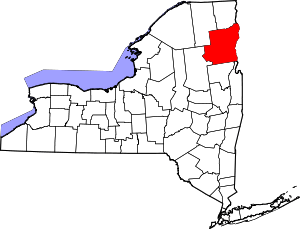Lake Placid, New York
Lake Placid is a village in the Adirondack Mountains in Essex County, New York, United States. As of the 2010 census, the population was 2,521.[3]
Lake Placid, New York | |
|---|---|
 Lake Placid from McKenzie Mountain | |
| Nickname(s): "The Olympic Village" | |
 | |
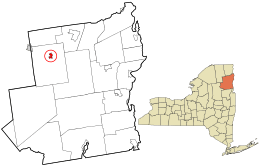 Location in Essex County and the state of New York. | |
| Coordinates: 44°17′08″N 073°59′07″W | |
| Country | United States |
| State | New York |
| County | Essex |
| Town | North Elba |
| Government | |
| • Type | Council / Manager |
| • Mayor | Evan Norkosky |
| Area | |
| • Total | 1.54 sq mi (3.98 km2) |
| • Land | 1.37 sq mi (3.55 km2) |
| • Water | 0.17 sq mi (0.43 km2) |
| Elevation | 1,801 ft (549 m) |
| Population (2010) | |
| • Total | 2,521 |
| • Estimate (2019)[2] | 2,357 |
| • Density | 1,719.18/sq mi (663.73/km2) |
| Time zone | UTC-5 (Eastern (EST)) |
| • Summer (DST) | UTC-4 (EDT) |
| ZIP code | 12946 |
| Area code(s) | 518 Exchange: 523 |
| FIPS code | 36-40761 |
| GNIS feature ID | 0954931 |
| Website | villageoflakeplacid |
The village of Lake Placid is near the center of the town of North Elba, 50 miles (80 km) southwest of Plattsburgh. Lake Placid, along with nearby Saranac Lake and Tupper Lake, comprise what is known as the Tri-Lakes region. Lake Placid hosted the 1932 and the 1980 Winter Olympics. Lake Placid also hosted the 1972 Winter Universiade, the 2000 Goodwill Games, and will host the 2020 ISU World Synchronized Skating Championships and the 2023 Winter Universiade.
History
Lake Placid was founded in the early 19th century to develop an iron ore mining operation. By 1840, the population of "North Elba" (four miles southeast of the present village, near where the road to the Adirondak Loj crosses the Ausable River), was six families. In 1845, the philanthropist Gerrit Smith arrived in North Elba and not only bought a great deal of land around the village but granted large tracts to former slaves. He reformed the land law and demonstrated his support of abolitionism.
The abolitionist John Brown heard about Smith's reforms, and left his anti-slavery activities in Kansas to buy 244 acres (1.0 km2) of land in North Elba. This parcel later became known as the "Freed Slave Utopian Experiment," Timbuctoo. Shortly before his execution in 1859, John Brown asked to be buried on his farm, which is preserved as the John Brown Farm State Historic Site.
As leisure time increased in the late 19th century, Lake Placid was discovered as a resort by the wealthy, who were drawn to the fashionable Lake Placid Club. Melvil Dewey, who invented the Dewey Decimal System, designed what was then called "Placid Park Club" in 1895. This inspired the village to change its name to Lake Placid, which became an incorporated village in 1900. Dewey kept the club open through the winter in 1905, which aided the development of winter sports in the area. Nearby Saranac Lake had hosted an international winter sporting event as early as 1889, and was used year-round by patients seeking treatment for tuberculosis at sanatoria. The fresh, clean mountain air was considered good for them and was a common treatment for tuberculosis at the time.
By 1921, the Lake Placid area could boast a ski jump, speed skating venue, and ski association. In 1929, Dr. Godfrey Dewey, Melvil's son, convinced the International Olympic Committee (IOC) Lake Placid had the best winter sports facilities in the United States.[4] The Lake Placid Club was the headquarters for the IOC for the 1932 and the 1980 Winter Olympics in Lake Placid.
In addition to the John Brown Farm and Gravesite, the Mount Van Hoevenberg Olympic Bobsled Run, New York Central Railroad Adirondack Division Historic District, and United States Post Office are listed on the National Register of Historic Places.[5]
Olympic Games
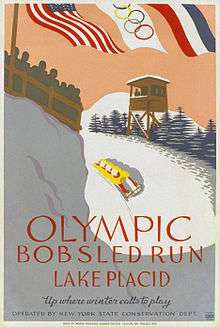
Lake Placid hosted the Winter Olympics in 1932 and 1980. During the 1932 games, the trails outside of the village served for the cross-country skiing events and the cross-country skiing part of the Nordic combined event.[6] Lake Placid, St Moritz, and Innsbruck are the only sites to have twice hosted the Winter Olympic Games.
Jack Shea, a resident of the village, became the first person to win two gold medals when he doubled in speed skating at the 1932 Winter Olympics. He carried the Olympic torch through Lake Placid in 2002 shortly before his death.[7] His grandson, Jimmy Shea, competed in the 2002 Winter Olympics in Salt Lake City, Utah, in his honor, winning gold in the Skeleton.
In the U.S., the village is especially remembered as the site of the 1980 USA–USSR hockey game. Dubbed the "Miracle on Ice", a group of American college students and amateurs upset seasoned and professional Soviet national ice hockey team, 4–3, and two days later won the gold medal. Another highpoint during the Games was the performance of American speed-skater Eric Heiden, who won five gold medals.
Lake Placid was interested in bidding for the 2016 Winter Youth Olympics but decided against it; Lillehammer, Norway, was the only bidder and was awarded the games. Lake Placid shifted its interest toward bidding for the 2020 Winter Youth Olympics, but it again did not submit a bid.[8]
Recreational opportunities
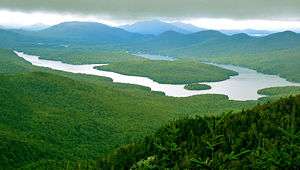
Lake Placid is well known among winter-sports enthusiasts for its skiing, both Alpine and Nordic. Whiteface Mountain (4,867 ft or 1,483 m), in nearby Wilmington about 13 miles (21 km) from Lake Placid, offers skiing, hiking, gondola rides, and mountain biking, and is the only one of the High Peaks that can be reached by an auto road. Whiteface Mountain has a vertical elevation of 3,430 feet (1,050 m), the highest vertical elevation of mountains in Eastern North America.[9][10] The area has one of only 16 bobsled runs in the Western Hemisphere.
In 2010, U.S. News & World Report highlighted Lake Placid as one of the "6 Forgotten Vacation Spots" in North America.[11]
Many people use Lake Placid as a base from which to climb the 46 High Peaks in the Adirondack Mountains. Those who complete these climbs may join the Adirondack 46ers.
Lake Placid built its first golf course in 1898, one of the first in the U.S., and has more courses than any other venue in the Adirondacks. Many of its courses were designed by well-known golf course architects, such as John Van Kleek, Seymour Dunn, Alexander H. Findlay, and Alister MacKenzie. The geographic features of the Adirondacks were considered reminiscent of the Scottish landscape, where the game started, and thus a fitting canvas for original play, or "mountain golf."
Lake Placid is near the West Branch of the Ausable River, a well-known stretch of water for fly fishing. More than 6 miles (10 km) of the West Branch are designated as year-round catch-and-release, artificial-lures-only water.
Regular sporting events

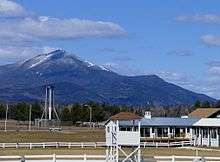
- Since 1999 it has been a site for the annual Ironman Lake Placid Triathlon, the second oldest Ironman in North America[12] and one of only ten official Ironman Triathlons to be held in the continental U.S.
- ESPN's Great Outdoor Games were inaugurated here in July 2000; they were held in Lake Placid again the following year, but moved to Madison, Wisconsin, in 2002 and were eventually discontinued.
- The Lake Placid and I Love New York Horse Shows have been held at the North Elba Showgrounds since 1969.
- Multiple IWPA (International Weight Pull Association) snow Weight pulling events are held at the North Elba Showgrounds yearly.
- Nearby Saranac Lake, New York, hosts an Annual Winter Carnival, one of the oldest Winter Carnivals in the country, complete with an Ice Palace.
- Lake Placid is also home to the Lake Placid Sinfonietta, a professional summer chamber orchestra that has existed since 1917 and offers concerts lakeside.
- The Winter Empire State Games are held in Lake Placid every February.
- The Lake Placid ice dance competition is held every year in July or August in the 1980 Olympic Arena.[13]
- CAN/AM hosts an adult pond hockey tournament on Mirror Lake every January.
- The Adirondacks Ragnar Relay race goes from Saratoga Springs to Lake Placid every September.
- The Lake Placid Summit Classic Lacrosse Tournament is held every year in early August since 1990.
Education
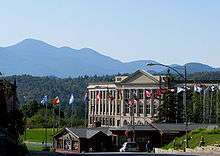
- Postsecondary education
- Primary and secondary education
- In Lake Placid, public education is administered by the Lake Placid Central School District.
Lake Placid is home to five private schools:
- Mountain Lake Academy
- National Sports Academy
- North Country School
- Northwood School
- St. Agnes School
Transportation
Lake Placid is served by nearby Adirondack Regional Airport in Saranac Lake, 16 miles (26 km) from the village. Lake Placid Airport, two miles south of the village, does not offer scheduled service but chartered flights are available.
Other relatively nearby airports include Albany International Airport, Burlington International Airport, Montréal-Pierre Elliott Trudeau International Airport, the airports in the New York metropolitan area, Ottawa International Airport, Toronto Pearson, and the airport in Plattsburgh. Lake Placid is also served by an Amtrak Thruway Motorcoach connection through Westport via limousine service. Adirondack Trailways stops there as well.
Lake Placid is not located on any interstate highway. It can be reached from Interstate 87 to the east via New York State Route 73, New York State Route 86, and New York State Route 9N. County Roads 21, 31 and 35 also serve the community.
In the 20th century the New York Central Railroad (NYC) operated sleeping cars to Lake Placid on trains such as the North Star and the Iroquois. The NYC operated passenger trains to Utica, New York for connections west towards Chicago and Buffalo and east toward New York City until 1965. Today it is also the northern terminus of the Adirondack Scenic Railroad, over former New York Central and Delaware & Hudson trackage. There are currently plans to restore service to Utica.
Geography
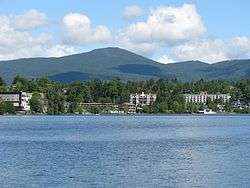
According to the United States Census Bureau, the village has a total area of 1.5 square miles (4.0 km2), of which 1.4 square miles (3.6 km2) is land and 0.15 square miles (0.4 km2), or 10.79%, is water.[3]
The village is located near the south end of Lake Placid lake. More immediate to the village is Mirror Lake, which lies between the village and Lake Placid.
Demographics
| Historical population | |||
|---|---|---|---|
| Census | Pop. | %± | |
| 1910 | 1,682 | — | |
| 1920 | 2,099 | 24.8% | |
| 1930 | 2,930 | 39.6% | |
| 1940 | 3,136 | 7.0% | |
| 1950 | 2,999 | −4.4% | |
| 1960 | 2,998 | 0.0% | |
| 1970 | 2,731 | −8.9% | |
| 1980 | 2,490 | −8.8% | |
| 1990 | 2,485 | −0.2% | |
| 2000 | 2,638 | 6.2% | |
| 2010 | 2,521 | −4.4% | |
| Est. 2019 | 2,357 | [2] | −6.5% |
| U.S. Decennial Census[14] | |||
As of the census[15] of 2000, there were 2,638 people, 1,303 households, and 604 families residing in the village. The population density was 1,913.2 inhabitants per square mile (738.7/km2). There were 1,765 housing units at an average density of 1,280.1 per square mile (494.2/km2). The racial makeup of the village was 95.75% White, 0.68% African American, 0.45% Native American, 0.91% Asian, 0.57% Pacific Islander, 0.19% from other races, and 1.44% from two or more races. Hispanic or Latino of any race were 0.91% of the population.
There were 1,303 households, of which 22.3% had children under the age of 18 living with them, 34.1% were married couples living together, 8.4% had a female householder with no husband present, and 53.6% were non-families. 45.7% of all households were made up of individuals, and 16.9% had someone living alone who was 65 years of age or older. The average household size was 2.02, and the average family size was 2.93.
The population was spread out, with 22.4% under the age of 18, 8.5% from 18 to 24, 33.2% from 25 to 44, 19.3% from 45 to 64, and 16.6% who were 65 years of age or older. The median age was 37 years. For every 100 females, there were 92.4 males. For every 100 females age 18 and over, there were 88.3 males.
The median income for a household in the village was $28,239, and the median income for a family was $43,042. Males had a median income of $26,585 versus $21,750 for females. The per capita income for the village was $18,507. About 8.5% of families and 13.2% of the population were below the poverty line, including 13.3% of those under age 18 and 17.8% of those age 65 or over.
Climate
According to the Köppen climate classification system, Lake Placid has a Warm-summer, Humid continental climate (Dfb). Dfb climates are characterized by a least one month having an average mean temperature ≤ 32.0 °F (0.0 °C), at least four months with an average mean temperature ≥ 50.0 °F (10.0 °C), all months with an average mean temperature < 71.6 °F (22.0 °C) and no significant precipitation difference between seasons. Although most summer days are comfortably humid in Lake Placid, episodes of heat and high humidity can occur with heat index values > 89 °F (32 °C). Since 1981, the highest air temperature was 93.9 °F (34.4 °C) on 08/03/1988, and the highest daily average mean dew point was 71.6 °F (22.0 °C) on 08/01/2006. The average wettest month is July which corresponds with the annual peak in thunderstorm activity. Since 1981, the wettest calendar day was 4.41 inches (112 mm) on 11/08/1996. During the winter months, the average annual extreme minimum air temperature is −27.1 °F (−32.8 °C).[16] Since 1981, the coldest air temperature was −34.4 °F (−36.9 °C) on 01/16/1994. Episodes of extreme cold and wind can occur with wind chill values < −42 °F (−41 °C). The average annual snowfall total (Oct-May) is between 100 inches (254 cm) and 125 inches (318 cm).
| Climate data for Lake Placid, Elevation 1,870 ft (570 m), 1981-2010 normals, extremes 1981-2018 | |||||||||||||
|---|---|---|---|---|---|---|---|---|---|---|---|---|---|
| Month | Jan | Feb | Mar | Apr | May | Jun | Jul | Aug | Sep | Oct | Nov | Dec | Year |
| Record high °F (°C) | 61.2 (16.2) |
63.2 (17.3) |
77.3 (25.2) |
87.6 (30.9) |
89.3 (31.8) |
91.7 (33.2) |
91.4 (33.0) |
93.9 (34.4) |
90.9 (32.7) |
78.9 (26.1) |
68.1 (20.1) |
63.6 (17.6) |
93.9 (34.4) |
| Average high °F (°C) | 26.0 (−3.3) |
30.1 (−1.1) |
38.4 (3.6) |
51.9 (11.1) |
64.5 (18.1) |
72.9 (22.7) |
76.5 (24.7) |
74.9 (23.8) |
67.5 (19.7) |
55.2 (12.9) |
42.3 (5.7) |
30.6 (−0.8) |
52.7 (11.5) |
| Daily mean °F (°C) | 15.3 (−9.3) |
18.3 (−7.6) |
26.7 (−2.9) |
40.0 (4.4) |
51.6 (10.9) |
60.6 (15.9) |
64.5 (18.1) |
62.9 (17.2) |
55.6 (13.1) |
44.4 (6.9) |
33.4 (0.8) |
21.3 (−5.9) |
41.3 (5.2) |
| Average low °F (°C) | 4.6 (−15.2) |
6.5 (−14.2) |
14.9 (−9.5) |
28.2 (−2.1) |
38.7 (3.7) |
48.2 (9.0) |
52.5 (11.4) |
50.9 (10.5) |
43.7 (6.5) |
33.6 (0.9) |
24.4 (−4.2) |
12.0 (−11.1) |
30.0 (−1.1) |
| Record low °F (°C) | −34.4 (−36.9) |
−30.2 (−34.6) |
−27.9 (−33.3) |
−1.8 (−18.8) |
20.0 (−6.7) |
25.3 (−3.7) |
33.4 (0.8) |
32.2 (0.1) |
21.6 (−5.8) |
12.0 (−11.1) |
−18.0 (−27.8) |
−30.1 (−34.5) |
−34.4 (−36.9) |
| Average precipitation inches (mm) | 2.60 (66) |
2.10 (53) |
2.62 (67) |
2.80 (71) |
3.47 (88) |
4.40 (112) |
4.29 (109) |
4.12 (105) |
3.94 (100) |
4.00 (102) |
3.48 (88) |
3.10 (79) |
40.92 (1,039) |
| Average relative humidity (%) | 75.4 | 70.8 | 66.7 | 63.2 | 63.2 | 71.7 | 73.1 | 76.5 | 77.0 | 74.2 | 79.0 | 81.8 | 72.7 |
| Average dew point °F (°C) | 8.9 (−12.8) |
10.4 (−12.0) |
17.1 (−8.3) |
28.5 (−1.9) |
39.5 (4.2) |
51.4 (10.8) |
55.7 (13.2) |
55.4 (13.0) |
48.5 (9.2) |
36.7 (2.6) |
27.6 (−2.4) |
16.6 (−8.6) |
33.1 (0.6) |
| Source: PRISM[17] | |||||||||||||
Ecology
According to the A. W. Kuchler U.S. potential natural vegetation types, Lake Placid would have a dominant vegetation type of Northern Hardwoods/Spruce (108) with a dominant vegetation form of Northern Hardwoods (23).[18] The plant hardiness zone is 4a with an average annual extreme minimum air temperature of −27.1 °F (−32.8 °C).[16] The spring bloom typically peaks around May 12th and fall color usually peaks around October 1st.

Notable people
.jpg)
- Bill Beaney (born 1951) college men's ice hockey coach, raised in Lake Placid
- John Brown (1800–1859), abolitionist
- Chadd Cassidy (born August 3, 1973), AHL coach, born and raised in Lake Placid
- Lana Del Rey (born 1985), singer, songwriter and poet; raised in Lake Placid
- John Desrocher (born 1964), United States Ambassador to Algeria, raised in Lake Placid
- Godfrey Dewey (1887-1977), president of the Lake Placid Organizing Committee for the 1932 Winter Olympics, son of Dr. Melvil Dewey
- Melvil Dewey (1851–1931), inventor of the Dewey Decimal Classification System for libraries and President of the American Library Association, founder of the Lake Placid Club
- Chris Ortloff (born 1947), former New York State Assemblyman, Chief of Ceremonies and Awards for the Lake Placid Olympic Organizing Committee for the 1980 Winter Olympics, born in Lake Placid
- Kate Smith (1907–1986), singer
- James Tolkan (born 1931), actor
- Craig Wood (1901-1968), Masters Tournament champion (1941), U.S. Open champion (1941), World Golf Hall of Fame entrant (2008)
Winter Olympic athletes
- Lowell Bailey (b. 1981), biathlete[19]
- Ashley Caldwell (b. 1993), biathlete[19]
- Art Devlin (September 7, 1922 – April 22, 2004) ski jumper, competed in the 1952 and 1956 Winter Olympics, earned three Purple Hearts along with other military honors serving in World War II, founder of Art Devlin's Olympic Motor Inn in Lake Placid, a color commentator for ABC Sports during the 1964, 1968, 1976 and 1980 Winter Olympics, led the effort to bring the 1980 Winter Olympics to Lake Placid. Born, raised, and lived in Lake Placid.
- Peter Frenette (b. 1992), ski jumper[19]
- Mark Grimmette (b. 1971), luge competitor
- Eric Heiden (born 1958), speedskater
- Haley Johnson (b. 1981), biathlete[19]
- Brian Martin (b. 1974), luge competitor
- Chris Mazdzer (b. 1988), luge competitor, 2018 Silver Medalist
- Jack Shea (1910-2002)
- Jimmy Shea (b. 1968)
- Kyle Tress (b. 1981), skeleton athlete
- Andrew Weibrecht (born 1986), alpine skier, 2014 silver and 2010 Olympic bronze medalist, born and raised in Lake Placid[19]
Gordon "Pete " Sears (b. 1947) , 1972 silver medalist ice hockey
References
- "2019 U.S. Gazetteer Files". United States Census Bureau. Retrieved July 27, 2020.
- "Population and Housing Unit Estimates". United States Census Bureau. May 24, 2020. Retrieved May 27, 2020.
- "Geographic Identifiers: 2010 Demographic Profile Data (G001): Lake Placid village, New York". U.S. Census Bureau, American Factfinder. Retrieved February 22, 2016.
- Fea, John, in Findling, John E. and Pelle, Kimberly D., editors, Encyclopedia of the Modern Olympic Movement, Greenwood Press, 2004. ISBN 978-0-313-32278-5. p. 297
- "National Register Information System". National Register of Historic Places. National Park Service. July 9, 2010.
- 1932 Winter Olympics official report. Archived 2008-04-10 at the Wayback Machine pp. 145–6, 199.
- "BBC SPORT - Winter Olympics 2002 - Skating - Winter Olympic hero dies".
- Lake Placid Leaning toward 2020 Youth Games Bid Archived 2010-09-21 at the Wayback Machine
- "Whiteface Lake Placid | the Perfect Winter Vacation." Whiteface. N.p., n.d. Web. 7 February 2015.
- "Lake Placid, Adirondacks." Ski Whiteface Mountain. N.p., n.d. Web. 7 February 2015.
- Miriam B. Weiner, "6 Forgotten Vacation Spots: Destinations that were hot only 20 years ago have since gone tepid, clinging to the memory of their glory days. But what caused the flux in the fad? Find out more about some of the travel industry's former heavyweights, what made them fall and whether or not they should have been forgotten." Yahoo Tavel, n.d. Found at U.S. News & World Report Travel website. Accessed December 8, 2010.
- Lake Placid Ironman Official Site
- "2008 Lake Placid Ice Dance Championships". Archived from the original on 2010-12-25. Retrieved 2014-12-19.
- "Census of Population and Housing". Census.gov. Retrieved June 4, 2015.
- "U.S. Census website". United States Census Bureau. Retrieved 2008-01-31.
- "USDA Interactive Plant Hardiness Map". United States Department of Agriculture. Retrieved October 9, 2019.
- "PRISM Climate Group, Oregon State University". Retrieved October 9, 2019.
- "U.S. Potential Natural Vegetation, Original Kuchler Types, v2.0 (Spatially Adjusted to Correct Geometric Distortions)". Retrieved October 9, 2019.
- "Meet Your Lake Placid Olympians!". www.adirnondack.net. Retrieved January 23, 2015.
External links
| Wikimedia Commons has media related to Lake Placid, New York. |
| Wikivoyage has a travel guide for Lake Placid. |


